Hello everyone, I am your Massage Therapist. In our hectic modern lives, pursuing a 'Happy Healthy Life' is no longer just a slogan, but a goal many actively strive for. Facing the challenges brought by work pressure and environmental changes, we often feel mentally and physically exhausted.Today, I want to share with you an ancient yet profoundly wise health maintenance method – foot reflexology, specifically focusing on the heart reflex zone located on the soles of our feet, our 'second heart'. By understanding and caring for this small area, we can not only boost our cardiovascular health but also effectively manage stress, infuse ourselves with abundant vitality, and truly take every step in a healthy and happy way.
1. Secrets of Your Feet: How Foot Reflexology Protects Your Health
You may have heard of 'foot massage,' but the profound meaning of foot reflexology extends far beyond that. This theory holds that our feet are like a microcosm of the entire body, covered with 'reflex zones' that correspond to various organs, glands, and systems. Imagine, if you put your left and right foot together, it's like a miniature map of your body.When we press these reflex zones, it's not just physical stimulation; more importantly, we are creating a connection with the function of the corresponding parts of the body. If a particular reflex zone is especially sensitive or has a crystalline/gritty feeling (sensations reflexologists associate with imbalances), it may indirectly suggest that the vitality of its corresponding organ is slightly lacking or its function is imbalanced. Through appropriate stimulation, we can help them restore harmonious function, thereby enhancing overall health.
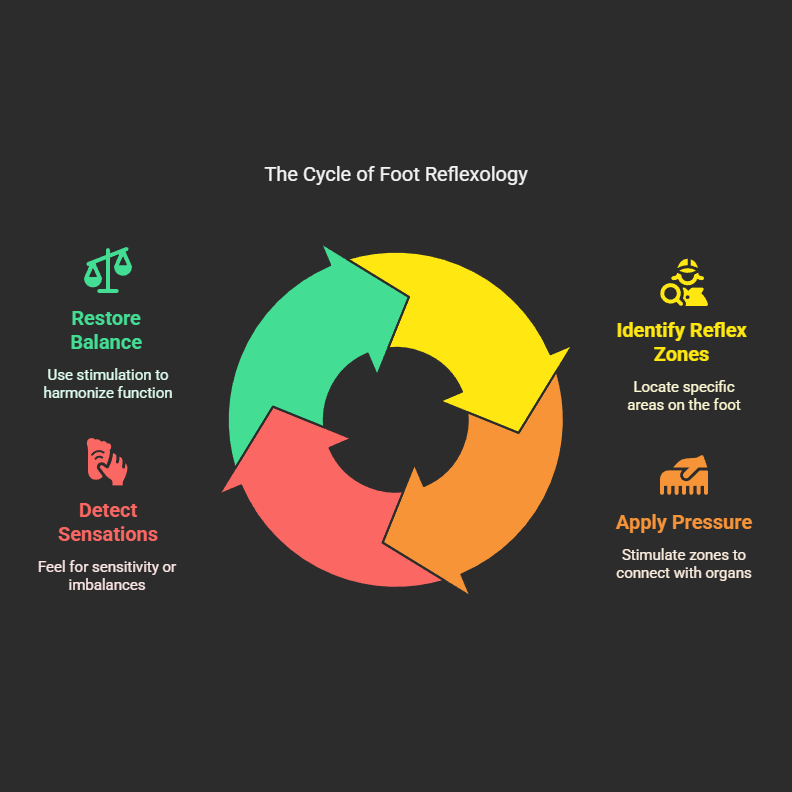
The therapeutic effects of foot reflexology primarily stem from its ability to promote our body's 'Three Key Flows for Wellbeing'.Firstly, promoting circulation: massage effectively improves blood flow in the feet and even the entire body, ensuring oxygen and nutrients are smoothly delivered to every cell, while also accelerating the elimination of metabolic waste.Secondly, channelling energy: from a Traditional Chinese Medicine (TCM) perspective, the feet are covered with meridians and acupoints. Massage here can harmonise Qi and Blood, balance Yin and Yang, and allow the body's energy to flow unimpeded.Lastly, re-establishing balance: by stimulating nerve endings in the soles of the feet, messages are transmitted to the central nervous system. This, in turn, regulates the function of corresponding organs, helping the body rediscover its natural state of balance and activating its self-healing potential.
2. Focusing on the Heart: Precisely Locating and Understanding the Heart Reflex Zone
When it comes to mind-body health, the heart undoubtedly plays a core role. In foot reflexology, the main reflex zone for the heart is located on the sole of the left foot.You can find it like this: counting from the big toe, locate the long bone below the fourth toe – this is the fourth metatarsal bone. The reflex zone is approximately in the front third section of this fourth metatarsal, towards the toes. More precisely, it covers the areas (or 'spaces') between the third and fourth metatarsal bones, and between the fourth and fifth metatarsal bones, and is roughly the size of your thumb pad.Although some schools of thought (or 'reflexology schools') mention related areas on the right foot and the top (dorsum) of the left foot, for daily self-care, we primarily focus on this key location on the sole of the left foot.
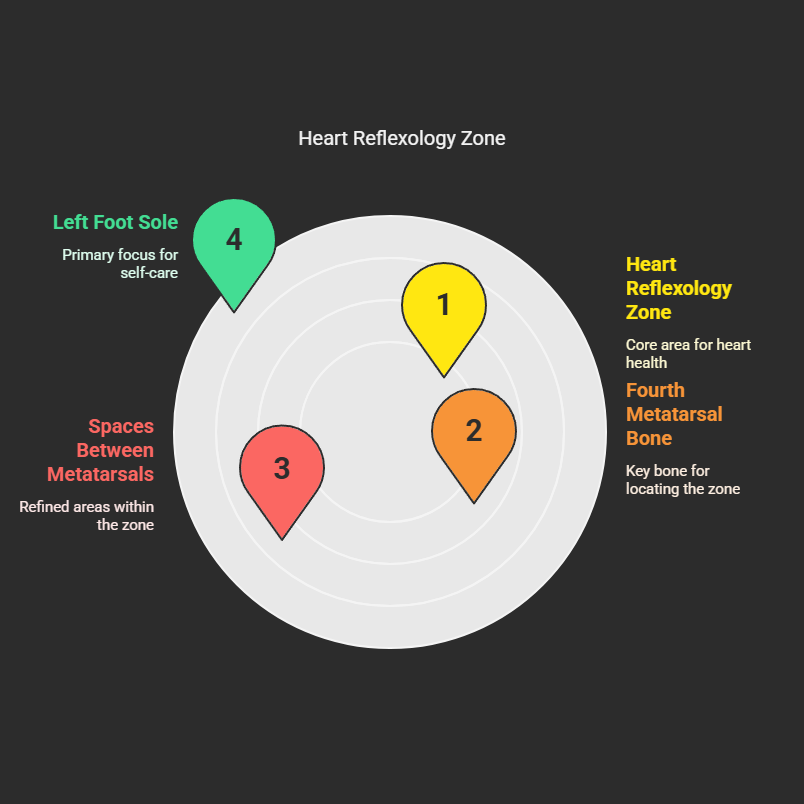
In Traditional Chinese Medicine (TCM) theory, the function of the 'Heart' (Xin) is far broader and more profound than the 'physical pump' referred to in Western medicine. TCM believes 'the Heart governs Blood and Vessels' (Xin Zhu Xue Mai), responsible for propelling blood circulation to nourish the entire body; this aspect is similar to modern medical views.But more importantly, TCM holds that 'the Heart houses the Shen (Mind/Spirit)' (Xin Cang Shen), meaning the Heart is the centre for our spirit, consciousness, thought, and emotional activities. The Heart is lauded as the 'Monarch Official,' commanding the Five Zang and Six Fu organs.Therefore, when we feel stress, anxiety, or emotional fluctuations, our 'Heart-Mind' (Xin Shen) – the state of our mind and spirit governed by the Heart – will be affected. This also explains why massaging the heart reflex zone can not only physiologically benefit the cardiovascular system but also effectively soothe emotions and relieve stress.
3. The Gift of the Heart Reflex Zone: A Dual Harmony for Cardiovascular Vitality and a Tranquil Mind
Appropriate stimulation of the heart reflex zone on the left foot can bring multiple benefits to our mind and body. Firstly, it helps to naturally enhance heart health. By promoting overall blood circulation, it ensures the heart receives sufficient oxygen and nutrients, supporting its natural pumping function. For individuals with cold hands and feet or poor circulation, regular massage of this area may bring improvement.Of course, it must be emphasised that foot reflexology is a form of supportive healthcare. If you have a history of heart-related conditions, you must follow your doctor's (GP's) advice and undertake any health activities under their guidance; absolutely do not regard it as a substitute for medical treatment.
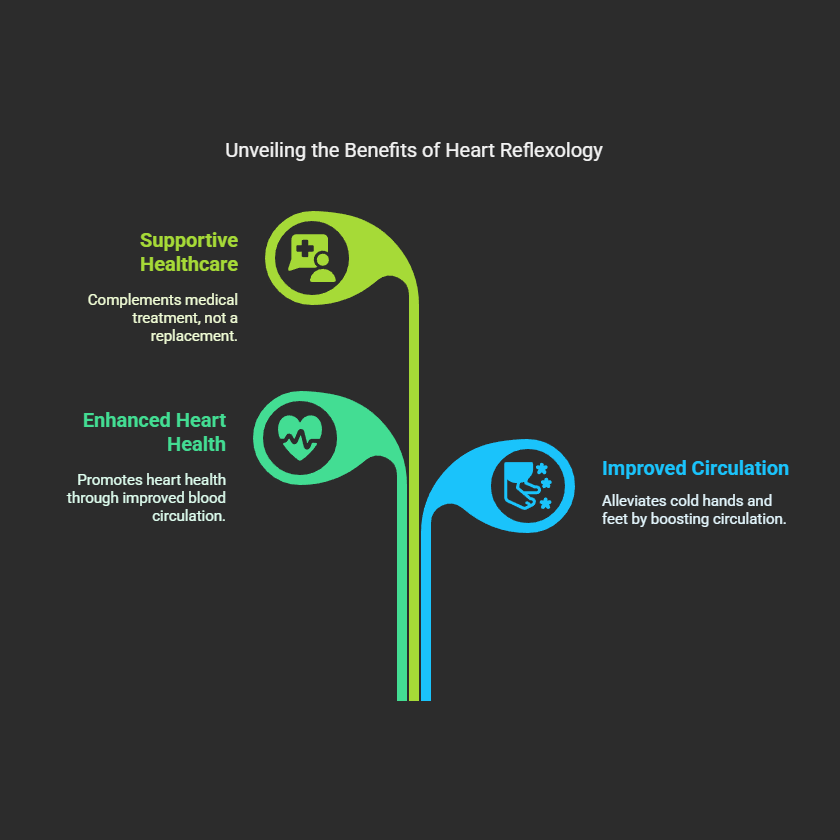
The fast pace of modern life often keeps us in a tense state, which in turn affects our sleep. Massaging the heart reflex zone, combined with its Traditional Chinese Medicine (TCM) characteristic of 'the Heart housing the Shen (Mind/Spirit)', can effectively relieve stress and anxiety, and improve sleep quality.Massage itself can guide the body into a state of relaxation and balance a dysregulated autonomic nervous system. Studies show that foot massage can promote the brain's secretion of pleasure-inducing serotonin, helping to relieve mental fatigue. When the mind (Shen) is soothed, emotions naturally stabilise, anxiety lessens, and falling asleep also becomes easier, allowing you to get genuine rest at night.
Working on the heart reflex zone through foot reflexology perfectly embodies the deep connection between mind and body. When stress is reduced and the mind (Shen) is tranquil, the burden on the cardiovascular system naturally decreases; conversely, when the body is comfortable and circulation is smooth, this also provides a solid foundation for psychological peace. This forms a wonderful virtuous circle.Therefore, integrating foot reflexology massage into daily life is not just about caring for specific organs, but is more significantly an active investment in your overall health. It helps to awaken the body's innate healing power, enhance immune function, and give us more energy to cope with life's various challenges.
4. Hands-on Care: A Practical Guide to Self-Massaging the Heart Reflex Zone
Before starting your self-massage, some simple preparations can greatly enhance its effects. Find a quiet and comfortable space, allowing yourself to completely relax. If time permits, you might first soak your feet in warm water for about 10-15 minutes, or apply a warm compress using a hot towel to your feet. This promotes foot circulation, making the muscles and reflex zones more receptive to massage.Prepare some natural massage lotion or your favourite plant-based essential oils and apply them to your feet to reduce friction; their aroma can also bring an additional healing sensation. Before you begin, take a few deep breaths and focus your attention on your feet and the self-care you are about to perform.
Once ready, let's proceed with massaging the heart reflex zone on your left foot. Reconfirm the location: on the sole of the left foot, approximately the front third of the fourth metatarsal bone (the long bone below the fourth toe) towards the toes, including the spaces between this bone and its neighbours (i.e., between the 3rd and 4th, and 4th and 5th metatarsals).You can try the following techniques:* **Thumb Pressing Method:** Use the pad or tip of your thumb to apply stable, sustained pressure to the reflex zone, or use rhythmic pressing and releasing. * **Thumb Pushing & Kneading Method:** Use your thumb pad on the reflex zone to slowly and deeply push and knead from the heel towards the toes (in a distal direction).If you want deeper pressure, you can bend your thumb and use your thumb knuckle to press.Ensure each part of the zone receives adequate stimulation. You can press for a few seconds then release, repeating this several times. Massage the entire area for about 1-3 minutes.
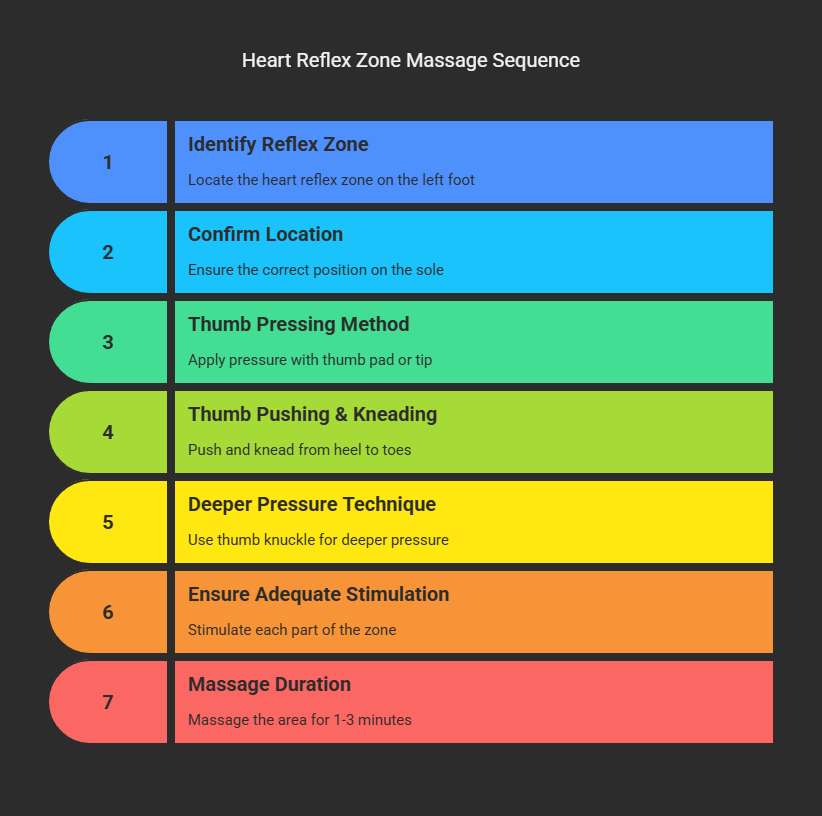
Mastering the correct pressure, duration, and frequency is very important; the core principle is to 'listen to your body's signals'. The ideal pressure is a level where you feel a 'mild aching, distending pain' or a 'painful yet comfortable' sensation. Avoid severe pain, as overstimulation can, conversely, make the body tense.When massaging the heart reflex zone for the first time, 1 to 3 minutes each time is sufficient. If you want to perform a full foot massage, aim for 3 to 5 minutes per foot. For routine health maintenance, 2 to 3 times a week is enough.If stress levels are high or you have specific conditioning needs, you can consider daily sessions, but always let your body's sensations be your guide; consistency is more effective than occasional forceful pressing.
5. The Body's Whispers: Interpreting Sensations and Safe Massage Guidelines
When massaging the heart reflex zone, you might feel sensations like aching, fullness, numbness, or pain, and may even feel fine granules or hard lumps (often described as 'crystals' in reflexology); these are all messages conveyed by the body through the reflex zone. Generally speaking, if a particular reflex zone is more sensitive or noticeably painful, it might suggest that its corresponding organ is somewhat fatigued or its function is imbalanced. For example, individuals with poorer heart function might find the heart reflex zone on the sole of their foot more tender to pressure.If massaging this area is painful AND is accompanied by daily symptoms such as general weakness, sweaty palms, left arm pain, or chest tightness, please be vigilant and seek a timely medical examination from your doctor (GP). But please remember, pain in a reflex zone does not equate to a medical diagnosis; rather, it serves as a reminder for us to pay more attention to that aspect of our health.
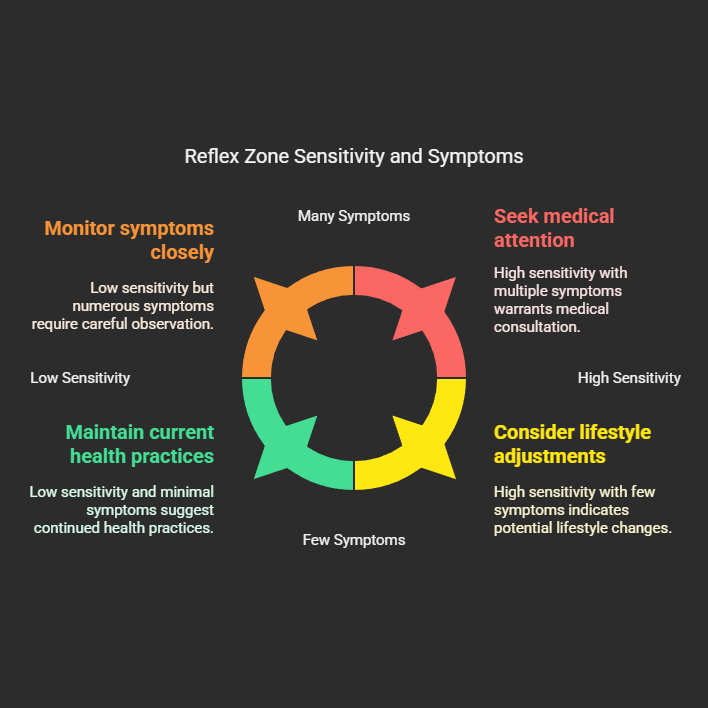
When performing foot reflexology, there are some basic points to keep in mind. After the massage, it is recommended to drink about 300-500 ml of warm boiled water to help eliminate metabolic waste. Avoid massaging within one hour after a meal to prevent it from affecting your digestion.If there are wounds, skin infections, or severe varicose veins on your feet, you should avoid that area or temporarily pause the massage. If you feel severe pain or persistent discomfort during the process, stop immediately or reduce the pressure.After the massage, pay attention to keeping your feet warm, especially in winter. These details help ensure the massage is safe and effective, allowing you to fully enjoy its benefits.
For individuals with specific health conditions, safety is always the primary consideration. Patients with severe heart disease must first consult their doctor (GP); massage pressure should be gentle, the duration short (e.g., massage of the heart reflex zone should not exceed 3-5 minutes), and they must continue with any prescribed medication.During early pregnancy (especially before 16 weeks), massage should generally be avoided, or your doctor (GP) must be consulted beforehand. When the body is experiencing acute inflammation or fever, massage is not advisable. It should also be avoided if there are open wounds or infections on the feet. Furthermore, it is unsuitable within one hour after a meal, when extremely fatigued and weak, or if a recent surgical wound has not fully healed.Crucially, if you have Deep Vein Thrombosis (DVT) or suspect such a condition, foot massage is strictly contraindicated.
6. Weaving Your 'Happy Healthy' Blueprint: Integrating Foot Reflexology into Your Life
Foot reflexology, especially the care of the heart reflex zone, is a precious and easy-to-implement component of the blueprint for achieving a 'Happy Healthy Life'. Please understand that reflexology aims to support the body's self-healing ability and promote internal balance, rather than being a standalone treatment.To achieve ideal health, it should be combined with other good habits: a balanced diet, regular exercise, high-quality sleep, effective stress management (such as meditation and cultivating hobbies), and regular health check-ups.Proactive self-care, such as foot reflexology, is an active investment in long-term health and happiness. If possible, seeking personalised guidance from a qualified foot reflexologist can further enhance its benefits.
Conclusion: Starting from Your Feet, Taking Healthier, Happier Steps Forward
In summary, by understanding and making good use of the heart reflex zone on our left foot, we find a natural and effective supportive way to maintain cardiovascular health and manage daily stress. Gentle pressing can not only potentially promote circulation and support the heart but also help soothe tense nerves and calm a restless mind, thereby improving overall mind-body well-being.Our feet, carrying the weight of our entire body, also hold hidden secrets to health. It is hoped that today's sharing will encourage you to start exploring the mysteries of foot reflexology. Whether through simple self-massage or seeking professional assistance, it will be a solid step on your journey towards a healthier, happier 'Happy Healthy Life'.
